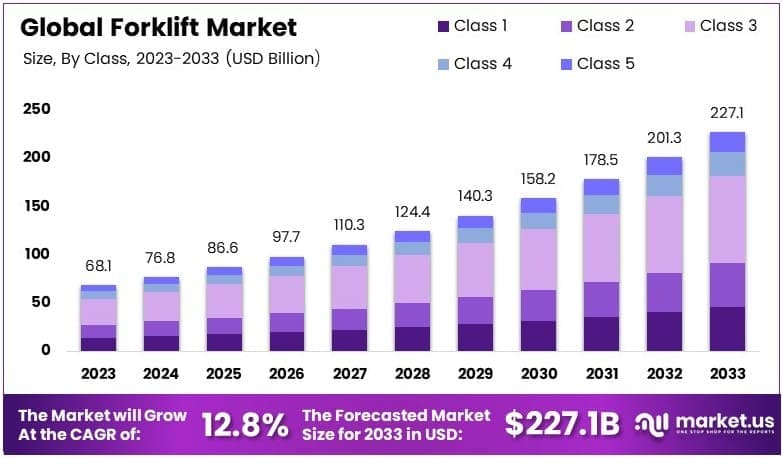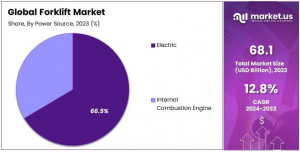
Forklift Market Share to Hit USD 227.1 Billion by 2033, Growing at a CAGR of 12.8%

Forklift Market Growth Analysis
forklift market is projected to grow from USD 68.1 billion in 2023 to USD 227.1 billion by 2033, with a CAGR of 12.8% during the forecast period.
NEW YORK, NY, UNITED STATES, January 28, 2025 /EINPresswire.com/ -- **Report Overview**
The Global Forklift Market is projected to reach USD 227.1 billion by 2033, up from USD 68.1 billion in 2023, growing at a compound annual growth rate (CAGR) of 12.8% from 2024 to 2033.
A forklift is a powered industrial vehicle designed to lift, transport, and stack materials in warehouses, construction sites, and manufacturing facilities. Equipped with a pair of forks or tines, it can lift heavy loads to varying heights, significantly improving operational efficiency in handling materials. Forklifts come in a variety of configurations, including electric, internal combustion, and hybrid models, each designed for specific applications. These vehicles are integral to industries like logistics, retail, and manufacturing, where material handling is essential for day-to-day operations.
The forklift market refers to the global industry that manufactures, distributes, and services forklifts, driven by demand across sectors such as e-commerce, construction, and manufacturing. This market encompasses both the sale of new forklifts and the aftermarket services related to maintenance and leasing, alongside technological advancements like automation and electric powertrains. The market's growth is heavily influenced by the ongoing demand for efficient and safer material handling equipment, particularly in the context of an expanding global supply chain.
Growth factors in the forklift market include increasing demand for automation, rising labor costs, and the need for sustainable energy solutions, such as electric forklifts. As companies continue to prioritize efficiency and safety, particularly in warehouses and logistics operations, forklift adoption is expected to rise. Furthermore, the rise of e-commerce has significantly boosted demand for advanced material handling equipment.
Request Your Sample Report Today for In-Depth Insights and Analysis at https://market.us/report/forklift-market/request-sample/
The opportunities in the forklift market are substantial, driven by innovations in robotics and electric vehicle technology. As industries seek to optimize their operations and reduce carbon footprints, the integration of automation and the shift towards electric forklifts present considerable avenues for growth and investment.
**Key Takeaways**
~~ The Forklift Market was valued at USD 68.1 billion in 2023 and is projected to reach USD 227.1 billion by 2033, growing at a CAGR of 12.8% during the forecast period.
~~ In 2023, Class III forklifts lead the market with a share of 39.7%, driven by their versatility in various warehouse operations.
~~ Electric-powered forklifts account for 66.5% of the market in 2023, reflecting the industry's shift towards more sustainable and energy-efficient solutions.
~~ Retail & Wholesale dominate the application segment, underscoring the critical role of forklifts in supply chain management.
~~ The Asia Pacific region holds the largest share at 37.0% in 2023, driven by the growth of logistics and manufacturing sectors in the region.
**Market Segmentation**
Class III forklifts lead the market with a 39.70% share due to their versatility in medium-duty tasks. They strike a balance between power, capacity, and maneuverability, making them ideal for warehouses, manufacturing, and distribution centers. Technological advancements in fuel efficiency and safety have reinforced their dominance. Class I forklifts are electric-powered, suited for light-duty, emission-free indoor tasks. Class II forklifts are used in narrow aisles, while Class IV and V forklifts cater to heavy-duty and specialized applications.
Electric forklifts dominate the market with a 66.5% share, driven by their environmental benefits, lower emissions, quiet operation, and reduced maintenance costs. Their suitability for indoor use, coupled with advancements in battery technology like lithium-ion batteries, boosts performance and sustainability. While Internal Combustion Engine (ICE) forklifts remain vital for heavy-duty tasks and outdoor environments with limited charging infrastructure, ongoing advancements ensure they continue to meet environmental standards.
The forklift market is dominated by the Retail & Wholesale sector, driven by the growing demand for efficient logistics and distribution in e-commerce. Forklifts are essential for moving and stacking goods in warehouses, supporting retail chains and wholesale businesses. Technological advancements, including automation, further enhance efficiency in this segment. Other applications, such as Manufacturing, Construction, and Healthcare, also contribute to the market's growth, with forklifts supporting production lines, transporting materials on job sites, and managing medical supplies.
**Key Market Segments**
By Class
~~ Class 1
~~ Class 2
~~ Class 3
~~ Class 4
~~ Class 5
By Power Source
~~ Internal Combustion Engine
~~ Electric
By Application
~~ Retail & Wholesale
~~ Manufacturing
~~ Construction
~~ Healthcare
~~ Others
**Driving factors**
Increasing Demand for E-commerce and Warehousing Solutions
The global forklift market is witnessing significant growth due to the increasing demand for e-commerce and efficient warehousing solutions. The rise in online shopping has necessitated the expansion of distribution centers and fulfillment warehouses, which require advanced material handling equipment, including forklifts. As more retailers and logistics companies optimize their supply chains to meet consumer demand, the need for forklifts, especially electric and automated models, is expected to surge. This shift is pushing the market towards higher sales volumes, creating a robust demand for more efficient and versatile lifting solutions to handle larger inventories and streamline operations.
"Order the Complete Report Today to Receive Up to 30% Off at https://market.us/purchase-report/?report_id=19428
**Restraining Factors**
High Initial Investment and Maintenance Costs
Despite the growing demand for forklifts, high initial investment and ongoing maintenance costs act as a restraint on market growth. Forklifts, particularly electric and automated versions, require significant upfront capital, which can be a barrier for smaller businesses or startups with limited budgets. Additionally, the maintenance costs associated with ensuring forklifts remain operational, including servicing, parts replacements, and regular inspections, can add to the overall ownership cost. This financial burden can delay purchases and potentially restrict the adoption of modern forklift technology, especially in cost-sensitive regions or industries.
**Growth Opportunity**
Advancements in Automation and Robotics Integration
One of the most promising opportunities in the forklift market lies in the integration of automation and robotics. Autonomous forklifts, capable of operating without human intervention, are revolutionizing the logistics and warehousing sectors. The growing emphasis on Industry 4.0 technologies and smart factories is pushing the demand for forklifts equipped with AI-driven systems, offering increased productivity and reduced labor costs. As these technologies become more affordable and efficient, businesses will have the opportunity to adopt automated solutions, significantly driving market growth and transforming traditional forklift operations into more streamlined, intelligent systems.
**Latest Trends**
Shift Toward Electric Forklifts for Sustainability
The forklift market is increasingly trending toward electric-powered models, driven by the growing emphasis on sustainability and environmental responsibility. Electric forklifts offer a cleaner alternative to traditional internal combustion engine forklifts, contributing to lower emissions, reduced noise pollution, and energy efficiency. As companies are increasingly pressured to meet sustainability goals and comply with stricter environmental regulations, the demand for electric forklifts is rising. This trend aligns with global initiatives toward green logistics and energy-efficient operations, positioning electric forklifts as a key growth driver in the market.
**Regional Analysis**
Asia Pacific Forklift Market with Largest Market Share of 37.0%
The Asia Pacific region leads the global forklift market, holding 37.0% of the share in 2023, valued at USD 25.20 billion. This dominance is driven by strong industrial growth, particularly in China and India, along with increasing demand from e-commerce and automation. The region is expected to maintain its leadership due to continued urbanization and technological advancements in material handling.
North America and Europe also contribute significantly, driven by demand in manufacturing, warehousing, and logistics, while Middle East & Africa and Latin America show emerging growth, supported by infrastructure development and industrial activities.
Overall, Asia Pacific remains the largest market, continuing its dominance in forklift demand.
!! Request Your Sample PDF to Explore the Report Format !!
**Key Players Analysis**
In 2024, the global forklift market is dominated by several industry leaders, each contributing to innovation and growth. Toyota Material Handling, Inc. maintains its stronghold due to its reputation for quality and extensive product range, driving its significant market share. Mitsubishi Logisnext Co., Ltd and Kion Group AG are also key players, leveraging advanced automation and electric forklift solutions to meet the increasing demand for sustainability.
Hyundai Heavy Industries Ltd stands out with its diverse portfolio, balancing traditional forklifts with electric and hybrid models. Anhui Heli Co. Ltd, based in China, continues to expand its footprint with cost-effective models catering to developing markets. Crown Equipment Corporation and Godrej & Boyce Group are renowned for their strong presence in material handling and a focus on ergonomic and energy-efficient designs. Other players like Komatsu Ltd, Doosan Corp., and CLARK Material Handling Co. offer specialized solutions, driving competition and fostering technological advancements in the market.
Top Key Players in the Market
~~ Toyota Material Handling, INC.
~~ Mitsubishi Logisnext Co., Ltd
~~ Hyundai Heavy Industries Ltd
~~ Kion Group AG
~~ Anhui Heli Co. Ltd
~~ Crown Equipment Corporation
~~ Godrej & Boyce Group
~~ Komatsu Ltd
~~ Doosan Corp.
~~ CLARK Material Handling Co.
~~ Other Key Players
**Recent Developments**
~~ In November 2024, Goscor Lift Trucks supplied 44 Bobcat lithium-ion forklifts to Access World for its Durban operations, reducing the company's carbon footprint by 3,080 tons, equivalent to planting 50,935 trees during the rental period.
~~ In October 2024, JLT Mobile Computers announced upgrades to its JLT1214™ Series forklift computers, featuring faster processors, enhanced wireless connectivity, and improved durability to boost operational efficiency in warehousing and material handling.
~~ In August 2024, Alta Equipment Group Inc. reported a $19.7 million revenue increase, totaling $488.1 million for Q2. The construction equipment and material handling segments contributed $294.9 million and $175.6 million, respectively.
**Conclusion**
The global forklift market is experiencing rapid growth, projected to reach USD 227.1 billion by 2033, from USD 68.1 billion in 2023, with a CAGR of 12.8%. This growth is driven by the increasing demand for efficient material handling solutions in e-commerce, logistics, and manufacturing, alongside the shift towards electric and automated forklifts for sustainability and operational efficiency. Despite challenges like high initial costs and maintenance, technological advancements, particularly in automation and robotics, present significant opportunities. Asia Pacific leads the market, with major players like Toyota Material Handling and Mitsubishi Logisnext driving innovation and market expansion.
Lawrence John
Prudour
+91 91308 55334
email us here
Visit us on social media:
Facebook
LinkedIn
Distribution channels: Manufacturing
Legal Disclaimer:
EIN Presswire provides this news content "as is" without warranty of any kind. We do not accept any responsibility or liability for the accuracy, content, images, videos, licenses, completeness, legality, or reliability of the information contained in this article. If you have any complaints or copyright issues related to this article, kindly contact the author above.
Submit your press release

